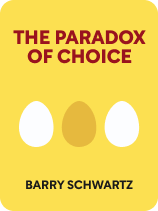

This article is an excerpt from the Shortform book guide to "The Paradox of Choice" by Barry Schwartz. Shortform has the world's best summaries and analyses of books you should be reading.
Like this article? Sign up for a free trial here .
What are the most noteworthy The Paradox of Choice quotes? What do these quotes mean in the context of Schwartz’s book?
In The Paradox of Choice, Barry Schwartz contends that the vast array of choices presented to us leaves us stressed and indecisive. To lift this burden, Schwartz, a professor of social theory and social action, recommends we learn how to better navigate our choices, from groceries to health insurance.
Here are some of the top quotes with explanations.
Quotes From The Paradox of Choice
Schwartz’s work combines psychology and economics. He wrote The Paradox of Choice based on his research and personal experiences with the negative consequences of expanded choice. In his book, he examines the types of choices we face, the challenges of making choices, how excessive choices make these challenges more difficult, and how to live with expanded choice.
Below are some of the best quotes from The Paradox of Choice.
“The existence of multiple alternatives makes it easy for us to imagine alternatives that don’t exist—alternatives that combine the attractive features of the ones that do exist. And to the extent that we engage our imaginations in this way, we will be even less satisfied with the alternative we end up choosing. So, once again, a greater variety of choices actually makes us feel worse.”
In addition to exacerbating the difficulty of making choices, Schwartz asserts that expanded choice comes with four distinct pitfalls: missed opportunities, regret, disappointment, and unfavorable comparison. It can also lead to anxiety, depression, and decision paralysis.
“Learning to choose is hard. Learning to choose well is harder. And learning to choose well in a world of unlimited possibilities is harder still, perhaps too hard.”
Schwartz establishes several steps toward making a good decision:
- Determine your goal(s).
- Consider how important each of your goals is.
- Lay out your options.
- Evaluate how each option can advance your goals.
- Choose the best option.
After you make your decision and put it into action, Schwartz recommends a sixth step of reflecting on the results and using what you learn to adjust future goals and how you approach them.
“If you seek and accept only the best, you are a maximizer.”
Maximizing and satisficing both come from a desire to make good decisions, but Schwartz argues that maximizing causes stress and eats up time much more than satisficing. If you maximize, you need assurance that every decision you make is the best you could have made. Because of this, maximizers aspire to consider every option they can, even for small decisions.
“The alternative to maximizing is to be a satisficer. To satisfice is to settle for something that is good enough and not worry about the possibility that there might be something better.”
Satisficers, on the other hand, consider their options and have high standards, but once they find an option that meets those standards, they accept it rather than continuing to explore options. Learning to be a satisficer, can lessen regret and improve life satisfaction. If you’re a maximizer and struggle with decision regret, try taking steps to satisfice, like setting standards, making firm decisions, and accepting options that are “good enough” instead of perfect.
“Unfortunately, the proliferation of choice in our lives robs us of the opportunity to decide for ourselves just how important any given decision is.”
In addition to narrowing our freedom of choice by engaging in close relationships, Schwartz recommends deciding which choices to spend time on, and which to make without much deliberation.
Schwartz cites the work of Cass Sunstein and Edna Ullmann-Margalit, who described decisions we shouldn’t have to think much about, and can therefore automate, as second-order decisions. They identify four categories of second-order decisions:
- Rules: By making rules for ourselves about certain choices (for example, that you always stop at stop signs), you can reduce the number of choices in your life.
- Presumptions: Like rules, presumptions are predetermined choices you make for yourself. However, you can change presumptions if your circumstances change. For example, if you start work each day at 9 a.m., you might set your alarm for 7 a.m. daily. Your presumption is to wake up at 7 each day. However, if you have an 8 a.m. doctor’s appointment, you might set your alarm for earlier.
- Standards: Standards are more flexible than rules or presumptions, but they still confine your choices. To set standards means to sort your options into two categories: acceptable and unacceptable.
- Routines: We build routines when we find something that meets our standards (for example, we buy the same latte at the same coffee shop every day).

———End of Preview———
Like what you just read? Read the rest of the world's best book summary and analysis of Barry Schwartz's "The Paradox of Choice" at Shortform .
Here's what you'll find in our full The Paradox of Choice summary :
- Why the more choices we have, the more stressed and indecisive we feel
- How to better navigate our choices, from groceries to health insurance
- Whether it's better to seek the best or accept "good enough"






